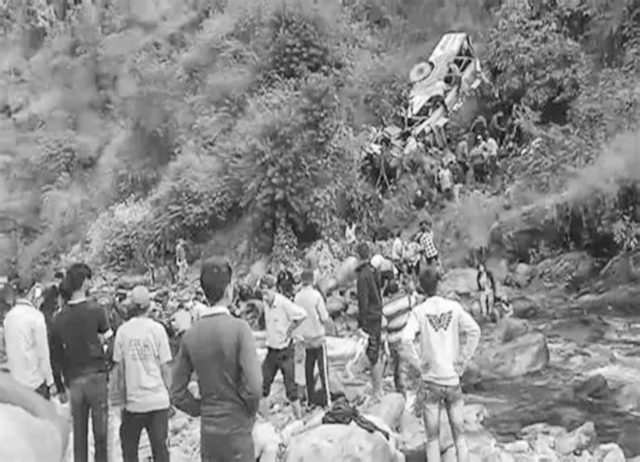 By Prof MM Semwal
By Prof MM Semwal
 By Sita Ramola
By Sita Ramola
Uttarakhand, the beautiful mountainous state nestled in the lap of the Himalayas, celebrated its Silver Jubilee, marking 25 years of statehood, on 9 November 2025. The state was formed on 9 November 2000, following a long struggle, numerous movements, and significant sacrifices. Initially named “Uttaranchal”, the state was renamed “Uttarakhand” in 2007, a name that better reflects the region’s historical and cultural identity. Being a mountainous state with unique geographical conditions, road transport is the primary mode of transportation in Uttarakhand. The state holds a significant place in the religious, cultural, and tourism sectors due to the world-famous Char Dham pilgrimage and the natural beauty of the Himalayas.
Roads were the backbone of the state’s development, connecting remote hills, enhancing tourism, and boosting the economy. When the state of Uttarakhand was formed in 2000, the total length of roads in the state was 15,470 kilometres. Today, this figure has increased to more than 36,000 kilometres. Every year, roads grow wider, but the margin for safety narrows.
The state’s unique topography and climate present distinctive road safety challenges. Steep inclines and winding roads require advanced driving skills and expert vehicle handling. Furthermore, visibility issues due to fog, the risk of landslides, and unpredictable mountain weather contribute to these challenges, increasing the likelihood of accidents. In regions like Uttarakhand, this problem is exacerbated by environmental and human factors, such as poor road infrastructure, vehicle overcrowding, and inadequate driver education. Road accidents in hill areas occur due to the complex and fragile nature of mountain roads, which differ significantly from those in the plains. More than 34,014 road accidents have occurred in the state in the last 25 years. The total number of road accidents, which was 1,523 in 2015, increased to over 1,750 in 2024. Recent official figures underscore the severity of this problem. In 2018 and 2019, Uttarakhand reported 1,418 and 1,553 road accidents, respectively, resulting in 1,047 and 868 deaths. This trend became even more alarming, with 1,674 accidents recorded in 2022, leading to 1,042 deaths, and 1,691 accidents in 2023, resulting in 1,054 fatalities. These figures rank Uttarakhand among the top six states in India with the highest severity of accidents, as measured by the death rate per 100 accidents.
In recent years, several devastating accidents have occurred in the hill regions of the state. In 2018, the Dhuma Kot bus accident claimed 48 lives, while the incident in Chakrata in October 2021 resulted in 11 deaths. In February 2022, a bus carrying a wedding party fell into a gorge in Champawat, killing 11 people, and in June 2022, a bus accident on the Yamunotri highway resulted in multiple deaths. More recently, in June 2024, a Tempo Traveller accident in Rudraprayag claimed 15 lives, and in the same year, a bus accident in Salt, Almora, resulted in 36 deaths. Six young people died on the spot in a car accident in Dehradun. Despite these recurring tragedies, effective improvements in road safety in Uttarakhand remain elusive. Under pressure from public outrage, authorities sometimes suspend lower or middle-level officials or implement temporary disciplinary measures. However, these steps fail to address the root causes, such as overloading, reckless driving, and poor road maintenance, that make these roads so dangerous.
Road accidents are proving fatal in Uttarakhand. The number of accidents and the resulting fatalities are increasing rapidly. The situation is so dire that Uttarakhand ranks sixth in the country for the number of deaths per 100 road accidents, while Himachal Pradesh, which has similar geographical conditions, ranks 20th. The severity of the situation can be gauged from the fact that approximately 105 people die in every 100 accidents in the mountainous regions. Although the average for the entire state is 69.53 deaths per 100 accidents, the national average is only 36 per cent. Evidence indicates that security measures have fallen behind development efforts.
Due to the rise in road accidents, the Uttarakhand government has started a series of planned actions to make the roads safer and lower the number of deaths. The Integrated Road Accident Database (iRAD) is one of the most important projects. Its goal is to make sure that scientific data is collected and analysed so that policies can be based on facts. The Sadak Suraksha Abhiyan is a large public awareness campaign that the government has also started to find black spots on major highways where accidents are likely to happen. Also, the Good Samaritan Law aims to make it easier for people who see an accident to help without worrying about getting in trouble with the law.
The New State Road Safety Policy 2025, which calls for the hiring of more Assistant Regional Transport Officers (ARTOs) in hill districts in order to improve institutional capacity locally, is one important policy development. In keeping with India’s commitment to the UN’s Decade of Action for Road Safety, the state has set a strategic goal to cut traffic accidents by 50% by 2030.
Nevertheless, the effectiveness of these measures will depend largely on their long-term implementation and monitoring. As Uttarakhand completes twenty-five years of its formation, it becomes imperative to assess, in the forthcoming decades, whether these initiatives result in measurable improvements in road safety. The period leading up to 2030 and beyond will serve as a critical test of the state’s ability to achieve its stated objective of halving road accidents and creating a safer transportation environment.
The state is celebrating its 25th anniversary, and the expanding road network tells a story of progress – but also of pain. Development without safety cannot be called a success. In the next 25 years, the focus must be not only on reaching destinations quickly, but also on ensuring that everyone arrives home safely.
(Semwal is head of Political Science Department at HNB Garhwal University. Ramola is a research scholar.)







